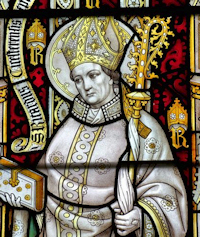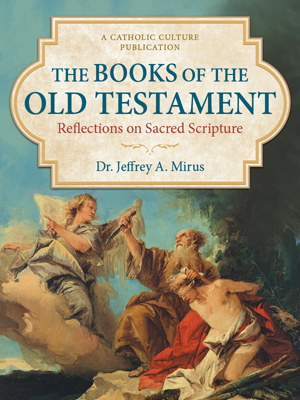Lent: April 3rd
Thursday of the Fourth Week of Lent
Other Commemorations: St. Richard of Chichester, Bishop (RM)
» Enjoy our Liturgical Seasons series of e-books!
More than any other Gospel, John gives us an insight into the suffering soul of Jesus. Today we have the “Moses Mass.” In it both readings speak of that great Prophet and Deliverer of the people. And we note how the plot against the Lord’s life is thickening. Moses is a type of Christ—the interceding suffering Mediator for God’s people. —The Vatican II Weekday Missal
The Roman Martyrology commemorates St. Richard of Chichester also known as Richard de Wych (1197-1253). Richard was born in Droitwich, Worcestershire, England, the son of a yeoman, farmer in 1197. After his excellent education at Oxford, Paris, and Bologna, Italy, including earning a doctorate in law he was appointed Chancellor. Later he was ordained in 1243 and became a reforming bishop of Chichester in England in 1245. The hymn "Day by Day" is attributed to him. He was generous in his charities and merciless towards simony and nepotism.
Meditation for Thursday of the Fourth Week of Lent—Christ’s Sacrifice on Calvary
The first reading of today’s Mass relates the intercession of Moses before Yahweh so that He should not punish his People’s infidelity. He invokes moving reasons: the good name of the Lord among the Gentiles, the faithfulness of his People to the Covenant made to Abraham and his descendants… And, in spite of their infidelities and the inconstancy of the chosen People, God forgives once more. Moreover, God’s love for his People, and through his People for the whole human race, will yet reach its supreme manifestation: For God so loved the world that he gave his only Son, that whosoever believes in him should not perish, but have eternal life.
Christ’s total self-surrender on our behalf, which reaches its culmination on Calvary, is an urgent call to us to correspond to his great love for each one of us. On the Cross, Jesus consummated his total self-surrender to his Father’s will, and showed his love for all men, for each and every person. He…loved me and gave himself for me. Faced with this unfathomable mystery of Love, I should ask myself, what do I do for him? How do I correspond to his love?
On Calvary, Our Lord, Priest and Victim, offered himself to his heavenly Father, shedding his blood, which became separated from his Body. This is how he carried out his Father’s will to the very end.
It was the Father’s will that the Redemption should be carried out in this way. Jesus accepts it lovingly and with perfect submission. This internal offering of himself is the essence of his Sacrifice. It is his loving submission, without limits, to his Father’s will.
In every true sacrifice there are four essential elements: and all of them are present in the sacrifice of the Cross: priest, victim, internal offering and external manifestation of the sacrifice. The external manifestation must be an expression of one’s interior attitude. Jesus dies on the Cross, externally manifesting (through his words and his deeds) his loving internal surrender. Father, into thy hands I comment my spirit! I have finished the task you committed to me, I have fulfilled your Will. He is, both then and now, at once Priest and Victim. Since, then, we have a great high priest who has passed through the heavens, Jesus, the Son of God, let us hold fast our confession. For we have not a high priest who is unable to sympathise with our weaknesses, but one who in every respect has been tempted as we are, yet without sinning.
The internal offering of Jesus gives full meaning to all the external elements of his voluntary sacrifice—the insults, the stripping of his garments, the crucifixion.
The Sacrifice of the Cross is a single sacrifice. Priest and Victim are one and the same divine person: the Son of God made man. Jesus was not offered up to the Father by Pilate or by Caiphas, or by the crowds surging at his feet. It was He who surrendered himself. At every moment of his life on earth Jesus lived a perfect identification with his Father’s will, but it is on Calvary that the Son’s self-surrender reaches its supreme expression.
We, who want to imitate Jesus, who want only that our life should be a reflection of his, must ask ourselves to-day in our prayer: do we know how to unite ourselves to Jesus’ offering to the Father and accept God’s will at every moment? Do we unite ourselves to him in our joys and our sorrows and in all the activities that make up each one of our days? Do we unite ourselves to him at the more difficult times, such as moments of failure, pain or illness, and at the easy times, when we feel our souls filled with joy?
My Mother and Lady, teach me how to pronounce a ‘yes,” which, like yours, will identify with the cry Jesus made before his Father: non mea voluntas…. (Luke 22:42)…not my will but God’s be done.
—Francis Fernandez, In Conversation with God

Thursday of the Fourth Week of Lent
Station with Santi Silvestro e Martino (St. Sylvester in the Head and St. Martin in the Hills):
Popularly called "San Martino ai Monti," this was probably one of the tituli or parish churches during ancient Rome under by St. Sylvester I and dedicated to St. Martin of Tours.
For more on Santi Silvestro e Martino, see:
For further information on the Station Churches, see The Stational Church.
St. Richard of Chichester
 St. Richard was born in 1197 at Wiche, near Worcester, England. When quite young, he and his elder brother were left orphans. Richard gave up his studies in order to manage his brother's impoverished farms. He succeeded so well that his brother desired to make over the estate to him. Richard refused not only the estate, but the opportunity of a brilliant marriage, since he desired to give himself to God's service. He resumed his studies which he had begun at Oxford, then in Paris. Returning to England he won his Master of Arts at Oxford, and then went to Bologna, Italy, to study canon law.
St. Richard was born in 1197 at Wiche, near Worcester, England. When quite young, he and his elder brother were left orphans. Richard gave up his studies in order to manage his brother's impoverished farms. He succeeded so well that his brother desired to make over the estate to him. Richard refused not only the estate, but the opportunity of a brilliant marriage, since he desired to give himself to God's service. He resumed his studies which he had begun at Oxford, then in Paris. Returning to England he won his Master of Arts at Oxford, and then went to Bologna, Italy, to study canon law.
St. Edmund, Archbishop of Canterbury, appointed him his Chancellor, and he accompanied the Archbishop when he was banished to France. After his death, Richard retired to a convent of Dominican Friars in Orleans, France, where he was ordained Priest.
When Bishop Nevil of Chichester, England, was dying, King Henry III recommended an unworthy court favorite to the See. The Archbishop declared him unqualified and the presentation void. He preferred Richard of Wiche to that dignity. Richard was consecrated in 1245, but the King refused to recognize the election and seized the revenues of the See. Richard suffered many hardships and persecutions for two years, repaying with favors those who persecuted him. He pleaded his cause before Pope Innocent IV against the King's deputies, and obtained a confirmation of his election.
 St. Richard performed his episcopal duties with fervor and charity towards his flock, and thoroughly reformed his See. After two years his revenues were restored. He preached the word of God with that unction and fruitfulness which only an eminent spirit of prayer could produce. Penitent sinners he received with great tenderness and charity, but when the rights of the Church were questioned he remained obdurate, fearing no consequences.
St. Richard performed his episcopal duties with fervor and charity towards his flock, and thoroughly reformed his See. After two years his revenues were restored. He preached the word of God with that unction and fruitfulness which only an eminent spirit of prayer could produce. Penitent sinners he received with great tenderness and charity, but when the rights of the Church were questioned he remained obdurate, fearing no consequences.
While preaching a holy war against the Saracens, at the Pope's command, St. Richard fell ill. He foretold his death, dying in a hospital at Dover on April 3, 1253, at the age of fifty-six. His body was conveyed to Chichester for internment in the Cathedral before the altar he had erected. Miraculous cures occurred at his tomb. The Saint was solemnly canonized by Pope Urban IV in 1262.
—From Heavenly Friends: A Saint for Each Day by Rosalie Marie Levy
Patronage: coachmen; Sussex, England; city of Chichester, England; diocese of Chichester
Symbols and Representation: bishop with a chalice on its side at his feet because he once dropped the chalice during a Mass and nothing spilled from it; kneeling with the chalice before him; ploughing his brother’s fields; a bishop blessing his flock with a chalice nearby
Highlights and Things to Do:
- Read more about St. Richard:
- Chichester Cathedral had a shrine dedicated to St. Richard and was a center of pilgrimage. In 1538, during the reign of Henry VIII, the shrine was plundered and destroyed by order of Thomas Cromwell. See this site for more details about St. Richard's relics.
- Richard of Chichester is the patron saint of Sussex in southern England; since 2007, his translated saint's day of June 16 has been celebrated as Sussex Day.
- The prayer from which the Hymn "Day by Day" takes its lyrics is attributed to St. Richard:
Thanks be to my Lord Jesus Christ
for all the benefits thou hast given me,
for all the pains and insults thou hast borne for me.
O most merciful redeemer, friend and brother,
may I know thee more clearly,
love thee more dearly
and follow more nearly.






